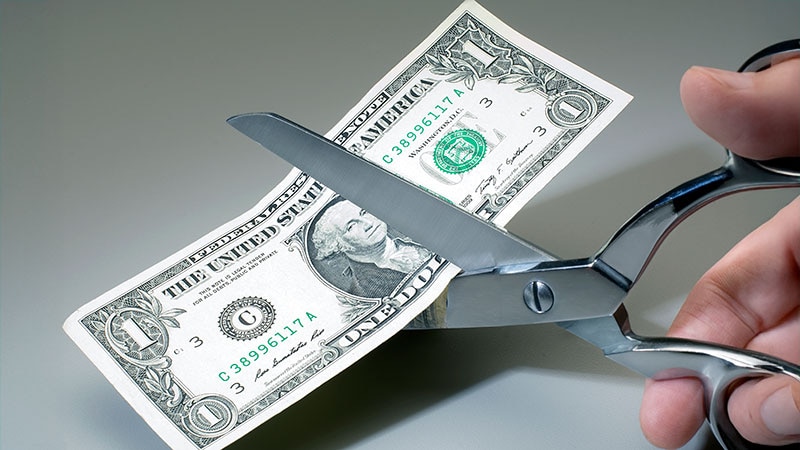A trio of cardiology groups is urging regulators not to proceed with a proposed 27% cut to Medicare reimbursement for a controversial procedure to prevent strokes in patients with atrial fibrillation (AFib).
The payment protest comes amid an ongoing recall of the device, called Watchman, over concerns of fatal air embolisms in some people who undergo the procedure without the use of positive pressure-controlled ventilation. Boston Scientific has reported 120 serious injuries and 17 deaths associated with the problem through July 30, according to the FDA. The warning does not apply to people who already have the device in place.
Percutaneous left atrial appendage occlusion or closure (LAAO or LAAC), is an option for patients who wish to avoid, or who cannot take, long-term oral anticoagulants to prevent blood clots. The small Watchman device is implanted to close off the left atrial appendage where blood clots often form in patients with AFib.
But some experts believe LAAO is more effective as a money maker for cardiology practices than as a way to reduce strokes.
Many cardiologists are now performing multiple LAAOs per day without keeping patients overnight in the hospital — raising revenue for their practice and reducing costs. As one poster on a Reddit sub-thread about the procedure wrote: “We do them same day even though we do them under general anesthesia. We do a [transthoracic echocardiogram] about 3 hours postop to recheck. Barring complications, we send [them] home. The attending that does the Watchmans at my place will do at least half a dozen in a day and just busts through them.”
Last month, the Centers for Medicare and Medicaid Services said it would reduce payments to clinicians who performed the procedure by 27%.
In response, the presidents of the American College of Cardiology (ACC), Heart Rhythm Society, and Society for Cardiovascular Angiography and Interventions (SCAI) said the move would “increase the risk of hospitalization and long-term disability for vulnerable patients.” According to their statement, “LAAO procedures reduce stroke while eliminating blood thinners. Ensuring that clinicians have the necessary resources to provide these high-value services that also reduce the cost of long-term medications will both improve patient outcomes and stabilize Medicare payments.”
Up to 20% of Americans will develop AFib in their lifetime, according to Srihari S. Naidu, MD, president of the SCAI. “The prevalence of AFib is increasing among our aging population,” he said. “There is abundant evidence that LAAO drastically reduces the risk for stroke in patients with AFib who meet the clinical indications. This benefit has been proven repeatedly in five major randomized controlled trials.”
Ensuring appropriate reimbursement for LAAO is fundamental, Naidu added. “Without it, hospitals will struggle to provide this critical therapy to patients in need,” he said. “At the end of the day, it’s patients who will suffer from these cuts when they cannot get the care they need to prevent stroke, as many of them may simply stop taking blood thinners without the protection afforded by LAAO.”
LAAO is considered a “high-value” cardiovascular procedure, according to Naidu. By definition, high-value care is high-quality care at the lowest achievable cost. “Patients are frequently discharged from the hospital on the same day as the procedure, and complete recovery takes only a few days,” Naidu said. “After LAAO, patients have protection from both AFib-associated stroke risk and the bleeding risk associated with the use of long-term blood thinners that, over time, become costly.”
Muhammad Bilal Munir, MD, a professor of medicine in the Division of Cardiovascular Medicine at the University of California Davis School of Medicine, Sacramento, agreed.
“Oral anticoagulants are recommended as a first-line approach in lowering stroke risk in eligible patients with AFib,” he said. “However, studies have shown significant underutilization of these drugs in real-world practice due to a multitude of factors. The LAAO devices were designed to address these unmet clinical needs.”
Side effects from anticoagulants, particularly bleeding, are common and LAAO avoids those reactions, Munir said.
Additional adverse effects associated with the LAAO procedure include leaks, bleeding complications, blood clots, systemic embolization, and stroke.
In a recent podcast for Medscape, John Mandrola, MD, a longtime critic of the procedure, cheered the cuts. “Since I strongly believe there is little to no benefit for these procedures — perhaps even a net harm — I consider this a positive,” Mandrola said.
He pointed out that the PROTECT AF trial comparing warfarin to Watchman was rejected by the FDA due to internal validity issues. “No clear data exist comparing LAAO to direct oral anticoagulants or no anticoagulants,” he said.
Anthony Pearson, MD, who writes a blog called The Skeptical Cardiologist, said patients need to understand LAAO is not a panacea. Some people are convinced to undergo the intervention without a full understanding of its potential benefits and risks — particularly the potential for device-related thrombus.
But Munir said while the earlier generation of Watchman had issues, improvements in device design have reduced the rate of complications associated with the procedure.
“Additionally, trials are taking place, such as the CHAMPION AF trial, comparing LAAO with direct-acting oral anticoagulants that will further inform and expand the clinical applicability of these devices,” he said. “The CMS cuts to such device reimbursements are significant and threaten patient safety and access to care.”
Naidu and Munir reported no relevant financial conflicts of interest.
Martta Kelly is a medical journalist based in the New York metropolitan area.
Source link : https://www.medscape.com/viewarticle/looming-pay-cut-laao-triggers-objection-card-groups-2025a1000l0j?src=rss
Author :
Publish date : 2025-08-07 14:45:00
Copyright for syndicated content belongs to the linked Source.
